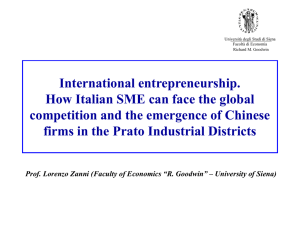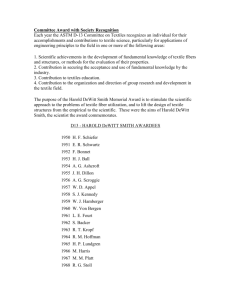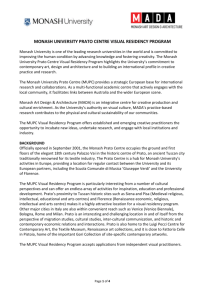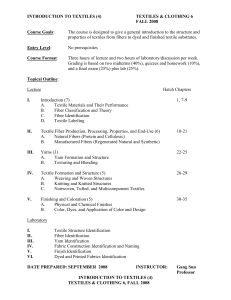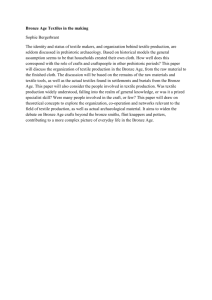Prato textile district - Unione Industriale Pratese
advertisement
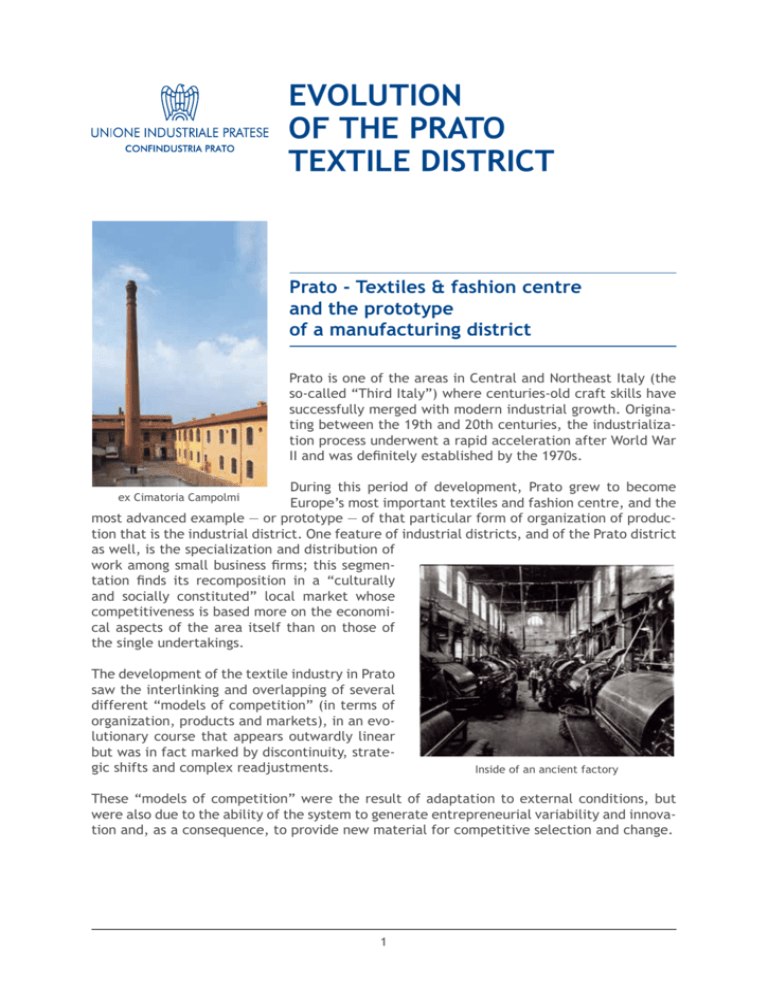
EVOLUTION OF THE PRATO TEXTILE DISTRICT Prato - Textiles & fashion centre and the prototype of a manufacturing district Prato is one of the areas in Central and Northeast Italy (the so-called “Third Italy”) where centuries-old craft skills have successfully merged with modern industrial growth. Originating between the 19th and 20th centuries, the industrialization process underwent a rapid acceleration after World War II and was definitely established by the 1970s. During this period of development, Prato grew to become Europe’s most important textiles and fashion centre, and the most advanced example — or prototype — of that particular form of organization of production that is the industrial district. One feature of industrial districts, and of the Prato district as well, is the specialization and distribution of work among small business firms; this segmentation finds its recomposition in a “culturally and socially constituted” local market whose competitiveness is based more on the economical aspects of the area itself than on those of the single undertakings. ex Cimatoria Campolmi The development of the textile industry in Prato saw the interlinking and overlapping of several different “models of competition” (in terms of organization, products and markets), in an evolutionary course that appears outwardly linear but was in fact marked by discontinuity, strategic shifts and complex readjustments. Inside of an ancient factory These “models of competition” were the result of adaptation to external conditions, but were also due to the ability of the system to generate entrepreneurial variability and innovation and, as a consequence, to provide new material for competitive selection and change. 1 The history — Take-off and consolidation of an industry Prato began to specialize in textiles in the 12th century, when garment manufacturing was regulated by the Wool Merchants’ Guild. The political and economic decline experienced in Italy during the 16th and 17th centuries caused a drop in textile activities, which resumed in the late 18th century with the production of knitted caps made for Arab markets. In the Prato area, industrial activities got under way at the end of the 19th century, with the introduction of mechanization (to which the brilliant local inventor Giovan Battista Mazzoni made important contributions) and with the “capitalistic” intensification of textile working processes that promoted their geographic concentration. The industrial take-off was also supported by foreign investors such as the Koessler and Mayer families of Austria, who created a company that lasted for decades and became locally known as the fabbricone, the big factory. A significant contribution to industrial expansion was also due to the lower costs of carded wool processing, caused by the gradually increasing production of recovered wool obtained from shredding old clothes and industrial scraps (“combings”); that was another feature that would characterize the town’s inward and outward image for decades. Basically, up to World War II the Prato textile industry was divided in two production circuits: one based on large (large for Prato) vertically integrated companies with generally low-level standard productions (rugs, military blankets, etc.) made for export to the poorer markets (Africa, India, etc.); the other based on groups of firms carrying out subcontract work for the production of articles designed for the clothing markets. Between the postwar period and the early 1950s, the outlets towards low-level standard production markets (India, Africa, etc.) rapidly disappeared, and the large vertically-organized companies quickly dissolved. The production system underwent a rapid evolution, and the result was not so much the decentralization of subcontract work but an original form of reorganization largely based on the widespread distribution of work among small-scale enterprises (the so-called “industrial district”). The two dynamic factors of the new system were: (a) the subcontracting firms, which carried out the actual production , and (b) the front-end firms, which were involved in product design, work organization and sales. The district-based model was compatible with many aspects of the previous production systems, but it was especially in line with the new profile assumed by the marketplace. The main business was still processing carded wool Rags’ selection from recycled materials; however, a crucial innovation made carded wool more competitive and more suitable for the clothing industry’s requirements for lighter fabrics: the introduction of nylon, which could be spun into yarns having a much finer count and could be interwoven with wool as “backing”. 2 This innovation helped to consolidate Prato’s position in its market segment (adding a wider range of patterns, colours, effects, etc.) and fuelled a rapid development that found fertile ground in the district in terms of: expertise, propensity for entrepreneurial risk-taking, availability of capital (also thanks to the local bank), a common language and a high degree of cooperation and mutual trust between all the parties involved. Wollen fabrics The history textile and fashion district The Prato district became thoroughly established during the 1970s. The emerging of fashion as a mass phenomenon, together with the higher salaries and the revolution in customs, marked a historical division in the clothing market (and not only), and the demand became more fragmented, differentiated, unsteady and seasonal. These variables disrupted the production and distribution chain forcing the structures to become more flexible, responsive and agile. The district was spurred to develop a “structural coupling” that resulted in its making a great leap forward — a surprising feat at a time when textile industries were in sensible decline throughout Europe and in non-district Italy (and with other national districts showing a poor performance). During that period the Prato district underwent a fundamental transformation, from a product-oriented, wool-processing district to a market-oriented, fashion/textile district. The re-orientation of its competitive identity in terms of “satisfied needs” cleared the way for a considerable increase in the variety of products and production technologies. During the seventies new possibilities were explored and developed, often with a pioneering spirit, in textiles (patterned combed yarns for knitwear, knitted fabrics, furs, coated fabrics, flock fabrics, etc.) and in non-wool fibres, both natural and synthetic. Since then, the fashion world (the world leaders in prêt-a-porter, the garment-makers for industrial brands, the large industrial retailers) would turn to Prato to find what other textile districts could not provide: constantly renewed collections of great variety and creativity and the ability to answer increasingly complex service requests. Spinning mill The second half of the 1980s proved a difficult period. The district was forced to dispose of the excess of investments in carded wool made during the previous decades, since the market for those products was rapidly dwindling. During that period, 28% of the workers lost their jobs and 37% of the firms went out of business. The crisis would be absorbed by the local system in the 1990s, thanks to a strong tertiary sector 3 Teasing with natural processing for noble fibres (with the fast growth of business services) and especially to a shift towards productions of greater added value and to differentiation of supply (e.g. fleece, chenille, etc.). The devaluation of the lira and the favourable international outlook (especially from 1993 onwards) prompted the district to invest heavily in production facilities, particularly in the finishing process, which became one of the most important sectors of the local production chain, with companies of above-average dimensions. Hence, textiles remained the driving force of the Prato area all through the nineties. A comparison between Dyeing plant 1991 and 2001 census data shows the importance that the textile industry continued to have in Prato’s economy: the number of workers in the textile and clothing sector was 50,333 in 1991 and 48,098 in 2001. In the rest of Italy, textile districts included, the trend was sensibly worse. Thus, at the end of the nineties, the Prato textile district appeared vital, competitive and in good working order, with a strong tertiary sector and considerable experience in product diversification, even in related sectors such as textile machinery. Fabrics warehouse Changes in the new millennium In 2001 this state of affairs was abruptly reversed, due to a combination of effects that accelerated structural changes in the textile/clothing sector worldwide. On the economic level, the main elements of change were: - the fall in demand caused by one of the longest postwar periods of stagnation/recession, which particularly hit the geographic markets (first of all Germany) and the market segments of reference (medium-to-high consumption) - the abrupt fall of the US dollar against the euro (and connected currencies, especially the Chinese renminbi), which had the effect of screening the potentially more dynamic markets and gave non-European competitors more weapons to use against Italian manufacturers. On the structural level, changes were enhanced by: - the stronger role of distribution networks and brand names, which favoured the concentration of operators, the international expansion of their range of action and the downstream shift of the processes that produced “value” and hence econo- 4 Details of the fabric given by Prato for Pope Giovanni Paolo II cope during the Jubilee of 2000 mic power in the supply chains - the increasing international integration of emerging economies with strong manufacturing capacities (not only in textiles!) and lower factor costs (also thanks to “illegal and/ or asymmetric” competition) - the interactions between the two preceding factors, which drove large retailers and garment makers to implement global-scale delocalization and seek out supply strategies that would offer any opportunity to cut down costs; and, at the same time, the delocalization strategies applied by textile operators, they too seeking lower cost factors and logistic proximity to the garment-making establishments. In this dramatic context, Prato’s textile industry underwent a serious downsizing in terms of companies, workforce, turnover, exports and added value, with the firms trying to survive through competitive selection and repositioning. Social transformations: the chinese migration wave of the second half of the 1990s The demand for labour in Prato and the employment opportunities created by the economic expansion that occurred during the postwar period could not be met by the local population alone. The area became a magnet that attracted migratory movements from many directions, which contributed to make Prato the third-largest city in central Italy and caused the uninterrupted urbanization of the plain extending from Florence to Pistoia. Up to the 1960s, the main contribution to filling Prato’s labour demand was provided by medium-range immigration, coming from the countryside and the small towns around Tuscany. That migratory movement was gradually integrated by workers arriving from southern Italy, who became predominant during the 1970s. Small towns from the Italian south moved to Prato almost completely, maintaining their sense of identity for years, chiefly because their settlements were concentrated in certain city districts. For that reason Prato has been often compared with Turin, although the former showed a better capacity for integration and social mobility. During the 1980s, the progressive drying up of southern immigration and the further reduced coverage of the lower segments of the labour market by the local population cleared the way for non-EU immigration, albeit in a context of a slower growing local economy and a diminishing number of manufacturing jobs. The new migratory influx concerned a large number of nationalities; these are currently more than 100, but in the 1990s the prevailing nationality was Chinese. the chineses in Prato The advent of “backyard globalization”, with its different cultures, religions, customs and languages, introduced an innovating factor among the relatively homogeneous Italian provinces, to which they were definitely unaccustomed. In the case of Prato, however, only the non-Chinese sectors of non-EU immigration (i.e. North-African, East-European, Pakistani, etc.) could be comprised in the classic categories that in those years 5 could be observed in other parts of Italy (factory workers, construction workers, carers for the elderly, etc.). The Chinese immigration showed peculiar characteristics, both in quantity and quality, and, apparently paradoxically, grew stronger during the years when Prato’s textile industry was experiencing economic hardships (after 2001). Chinese workers rarely sought employment in Italian-owned companies. Instead, they established a large network of small or very small firms where they manufactured knitwear and high-street fashion garments. The firms had a short average lifespan and employed Chinese personnel only, except for very few better-structured companies that also employed Italian executives. Over the years, the Chinese-owned companies showed a tendency towards “ethnic vertical integration”, buying subcontracting firms for garment processing and dyeing, supply firms in general (e.g. clothing accessories) or firms providing services to their businesses (consulting, IT, etc.) and community (commerce, personal services, etc.). Hence, a sort of “parallel district” developed that established itself in the facilities vacated by the textile firms that were leaving the business (ideally: mixité, small sheds, etc.) and that found legal grounds for their activities in the laws on immigration. However, a good portion of the Chinese presence could and can still be considered “irregular”, also because of the insufficient attention (before) and the scarce controls (after) provided by the appointed authorities. View of an industrial area Thus, following a typically selfreinforcing process that was also enhanced by the common region of origin, the expansion of the Chinese community and entrepreneurial activity reached impressive levels, that rapidly and deeply affected the linguistic, cultural and physical features of large parts of the Prato area. The following numbers may help to quantify the phenomenon. According to the most recent data available, 13.5% of the residents of the province of Prato are of foreign origin — the highest percentage among Italian provinces. In the city of Prato, 15% of the residents are of foreign origin, compared to a national average of 7.5% and to 10.6% and 10.2% in Lombardy and in the Veneto region (the two Italian regions having the largest number of foreign residents). In 1990, the number of Chinese residents in the city of Prato was 169; in 2012 it was 11,882. In June 2012, at the Chamber of Commerce of Prato the number of firms registered as having Chinese ownership was 4,830, representing a 180% increase in 10 years. These figures are amazing, even though they are limited to the “regularly resident” Chinese population only. If we also take into account the visitors who are present with a temporary residence permit, the Chinese population in Prato exceeds, in absolute value, every other Italian province including Milan. According to the latest available official data the Chinese nationals are more than 45,000 — the second-largest Chinese community in Europe after Paris. 6 The situation is truly unequalled both in terms of quality and quantity, and has the potential to produce disruptive effects even in a town like Prato, that is historically and socially accustomed to immigration and integration. The challenges facing the district The real challenge before the Prato textile district was and is the ability to further change its bearings, in order to adapt to the profound structural transformations that have been outlined above. Istituto Buzzi’ laboratory However, certain strategic aspects that seem less assailable by the new competitors are highly consistent with the wealth of expertise and organizational skills that has developed among Prato’s business establishments over the years: - the ability to offer constant creativity and fast reaction times to the requirements of the market seem consistent with the end markets, that need to be continuously stimulated, and with a supply chain that needs to cut the interval from design to production, with a view, among other things, to minimizing the risks of unsold goods - the capacity to propose top-quality articles with a high fashion content appears consistent with the demands of market segments that seem to be progressively growing (leaving aside the cycles and nervousness caused by the fluctuations of economic trends) - the know-how and facilities in carded wool processing accumulated over the years do not seem vulnerable to the new competitors, given their modest importance in the global fibre-processing sector (in general, wool represents 3% of global fibre production). The ability to confront these strategic aspects also depends on factors that are endogenous to the local system, in particular the capacity for adequate strategies to be implemented not only by business firms but by the “district community” as a whole. Regarding the business firms, the following aspects seem particularly critical: - strengthening the relations between the sector companies (front-end firms/subcontractors), by improving long-term collaborations that might be further cemented through equity ties - applying stronger controls on the market, through directly-operated networks of distribution - the capacity to internationalize production facilities, when the opportunities are advantageous - strengthening and formalizing the capacity to invest in product development and innovation, and further improving procesInside of a finishing mill sing time by dedicating more resources to the crucial ICT sector. These areas of improvement are closely tied to the problem of increasing the organizational capacity (which is linked to but does not coincide with dimensional growth) which, in this sense, can be considered a crucial node. 7 In a wider perspective, another endogenous issue regards the district’s socio-economic mechanisms. According to Prof. Giacomo Becattini, the greatest scholar of districts, a district is more than an aggregation of business firms — it is a system, a community of firms and people. Therefore, it is necessary not to disperse the district community’s overall capacity to “believe” and to renovate its institutions, not to lose confidence in industry, and not to destroy the will of the individuals and families to “go for it”, to start a business, to take risks. In this essentially socio-economic sense, the presence of and the relations with the Chinese community assume a very central position, and stand out as an issue requiring a strong capacity for governance (also in terms of resources and projects), especially on the two sensitive and converging aspects of legality and of full socio-cultural integration. The history of our district is dotted with shocks and marked by profound transformations. Once again, the future of Prato will depend on its ability to dynamically generate “adaptation and change”, following a perspective of evolution and not of decline, in our difficult and contradictory age of globalization. The Prato district today: figures The textiles and clothing sector in Prato* 2014 Turnover................. 4,192 Exports.................. 2,483 Business firms........... 7,194 Workforce ............. 34,746 * By ISTAT, Aida Bureau Van Dijck, Registro delle Imprese, Unione Industriale Pratese Images and credits: Museo del Tessuto - www.museodeltessuto.it Asvaip - www.asvaip.it Redazione “Wan Li” Isituto tecnico industriale “T. Buzzi” 8




